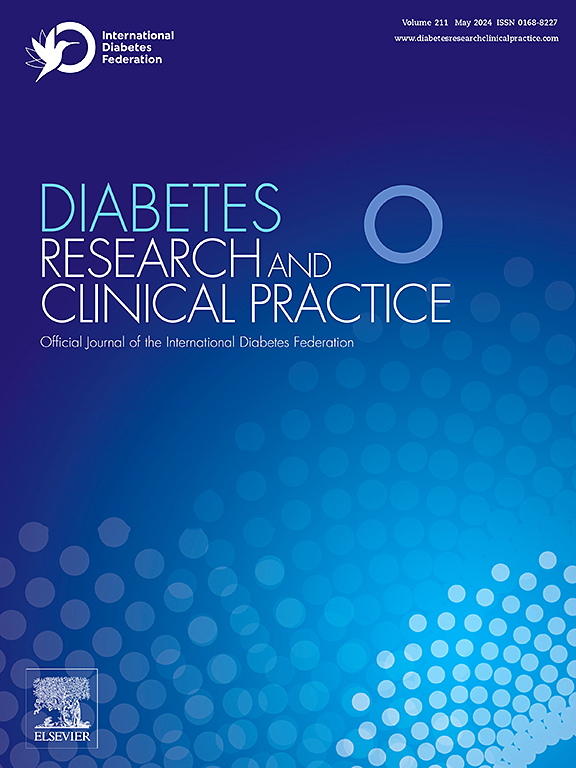Metabolic crosstalk and therapeutic interplay between diabetes and hyperuricemia
IF 6.1
3区 医学
Q1 ENDOCRINOLOGY & METABOLISM
引用次数: 0
Abstract
Hyperuricemia and diabetes mellitus (DM) are prevalent metabolic disorders with high comorbidity, imposing a substantial global public health burden. Their coexistence is not merely additive but synergistic, exacerbating metabolic dysregulation through mechanisms such as insulin resistance and β-cell apoptosis, ultimately establishing a vicious cycle. Both disorders induce acute and chronic damage to vital organs, particularly the cardiovascular, renal systems. Hyperuricemia aggravates diabetic complications, notably diabetic cardiomyopathy, nephropathy and retinopathy via oxidative stress, inflammation, and metabolic dysregulation. Current urate-lowering therapies (ULTs), such as xanthine oxidase inhibitors and urate transporter 1 (URAT1, also known as SLC22A12) antagonists, demonstrate potential benefits in ameliorating diabetic complications but face challenges including safety concerns and dose adjustments. Similarly, several glucose-lowering drugs also exhibit the benefits of improving hyperuricemia. This review summarizes the metabolic crosstalk and therapeutic interplay between hyperuricemia and DM, examines the pathogenic role of uric acid in diabetic complications, and discusses the benefits and challenges of existing ULTs and glucose-lowering drugs in disrupting this cycle of metabolic dysregulation and concurrent organ damage. We hope our findings deepen the comprehension of the intricate metabolic crosstalk between glucose and urate homeostasis, providing novel therapeutic insights for patients with comorbid DM and hyperuricemia.

糖尿病和高尿酸血症之间的代谢串扰和治疗相互作用
高尿酸血症和糖尿病(DM)是普遍存在的代谢性疾病,具有很高的合并症,给全球公共卫生造成了沉重的负担。它们的共存不仅是相加的,而且是协同的,通过胰岛素抵抗和β细胞凋亡等机制加剧代谢失调,最终形成恶性循环。这两种疾病都会对重要器官,特别是心血管和肾脏系统造成急性和慢性损害。高尿酸血症通过氧化应激、炎症和代谢失调加重糖尿病并发症,特别是糖尿病心肌病、肾病和视网膜病变。目前的尿酸降低疗法(ult),如黄嘌呤氧化酶抑制剂和尿酸转运蛋白1 (URAT1,也称为SLC22A12)拮抗剂,在改善糖尿病并发症方面显示出潜在的益处,但面临包括安全性问题和剂量调整在内的挑战。同样,几种降糖药物也显示出改善高尿酸血症的益处。本文综述了高尿酸血症与糖尿病之间的代谢串扰和治疗相互作用,探讨了尿酸在糖尿病并发症中的致病作用,并讨论了现有的ult和降糖药物在破坏代谢失调和并发器官损伤的循环中的益处和挑战。我们希望我们的发现能加深对葡萄糖和尿酸稳态之间复杂代谢串扰的理解,为合并糖尿病和高尿酸血症的患者提供新的治疗见解。
本文章由计算机程序翻译,如有差异,请以英文原文为准。
求助全文
约1分钟内获得全文
求助全文
来源期刊

Diabetes research and clinical practice
医学-内分泌学与代谢
CiteScore
10.30
自引率
3.90%
发文量
862
审稿时长
32 days
期刊介绍:
Diabetes Research and Clinical Practice is an international journal for health-care providers and clinically oriented researchers that publishes high-quality original research articles and expert reviews in diabetes and related areas. The role of the journal is to provide a venue for dissemination of knowledge and discussion of topics related to diabetes clinical research and patient care. Topics of focus include translational science, genetics, immunology, nutrition, psychosocial research, epidemiology, prevention, socio-economic research, complications, new treatments, technologies and therapy.
 求助内容:
求助内容: 应助结果提醒方式:
应助结果提醒方式:


